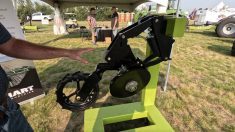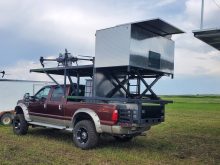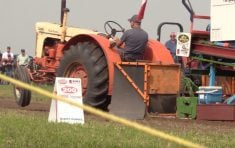Glacier FarmMedia — Ag in Motion is celebrating its 10th year. Building the show into the event it is today has taken years of careful planning.
“I felt like this was a once in a lifetime opportunity, to start something from scratch. It was very attractive to do that,” says Rob O’Connor, the show’s director since 2014.
O’Connor previously worked with the Regina Exhibition Association and acted as manager for what’s now called Canada’s Farm Show. He was working at the Provincial Exhibition of Manitoba in Brandon, when he received the call to work with Ag in Motion.
Read Also

K-Hart introduces new Spyder drill options for 2026
The 2026 models of the Spyder air drill, made by Prairie equipment manufacturer K-Hart Industries, will have new options available for farmers, with a particular focus on the drill’s openers.
“I chose to come to Glacier FarmMedia. It was easy for me to make that switch, even though I did really enjoy what I was doing in Brandon,” he says.
Prior to starting Ag in Motion, Glacier FarmMedia bought Canada’s Outdoor Farm Show at Woodstock, Ont. in 2011. Glacier ran that show with the intent of learning how a large outdoor trade show ran, so it could decide if they could create one in Western Canada.
The initial team to set up Ag in Motion included O’Connor, people from Canada’s Outdoor Farm show in Woodstock, and people in Winnipeg and in Alberta.
“We kind of looked at whether the show was viable, and we felt it was,” he says.
The team scouted locations all over the Prairies, before deciding to set the show near Saskatoon. They decided the show would run the third Tuesday to Thursday during July.
The first show involved a bit of scrambling. After a few glitches to find land and good partners, the team bought a piece of land around Langham, Sask., close to both Saskatoon and a major highway. The trade show area itself is about 100 acres, while parking is around 60 acres. Seventy acres are devoted to demonstration space, and there is also a large space for crop plots.
With the help of staff from Canada’s Outdoor Farm Show, the Ag in Motion team prepared a big launch in January to announce the new show.
Early supporters of Ag in Motion included the Saskatchewan government, the University of Saskatchewan and 40 companies who committed before the show even launched. From January to June, Ag in Motion was able to attract about 120 more companies to participate in the show.
“The last six weeks before the show, we had a pretty good blitz and we ended up attracting about 50 more companies. In the end, we had about 200 companies at our very first show,” O’Connor says.
The show was marketed through Glacier FarmMedia publications, such as the Western Producer, Grainews and Canadian Cattlemen, and through a promotional radio program.
There was a lot to do at the site, O’Connor says, because it hadn’t been an active farm. The team planted 100 acres of grass, and built a bunch of grid roads, so the show site would feel like a site for an annual event.
“We wanted to show people we’re putting our roots in this property and investing in it,” he says.
The first show attracted 11,000 people, mostly from the Prairie provinces, as well as a few people from the U.S., British Columbia and Ontario. From that initial year, the show has grown, with 31,000 people attending in 2023. Last year, show attendees filled up hotels in Saskatoon and Warman. People also stayed in hotels in the Battlefords, a 45-minute drive from Saskatoon.
“To have that kind of impact on tourism for that part of the province is important to us,” O’Connor says.
‘Opportunity’
One of the reasons the show has been so successful is because it is framed as an agricultural production trade show, he says.
“It’s really business-to-business. It’s not a business-to-consumer show, because we recognize farms as a business. And I think that’s unique.”
There has been major growth in the demonstrations program since the initial show.
“That first year, we gave people a taste of what we were going to do. We tried to get some companies to do some demonstrations. One thing that’s been a big benefit to the show is, not only do we have those demonstrations where three to five companies can demonstrate something like air seeders or tillage equipment, but we also give companies the opportunity to have space at the show so they can demonstrate their own product,” he says.
In some years, about 20 companies demonstrate their own equipment, which could be anything from a rock picker to a truck.
To represent agriculture in Western Canada, the Ag in Motion show also includes livestock equipment. About 25 per cent of the exhibitor base are livestock and forage-based businesses, which has resulted in more livestock equipment demonstrations, and sessions of interest to ranchers.

Show topics change every year.
“It has a lot to do with what the industry is doing now and what we think the industry is going to do in the future. One thing that has grown in the last couple of years is our ag tech programming. That’s grown out of our original innovations program,” he said.
The ag tech programming allows companies to show new products to farmers.
“Those innovators, those ag tech companies and associations, they can test their ideas with the farmer base to find out if they’re going down the right path, and if they’re actually going to be a solution to some of the problems producers have in agriculture,” O’Connor says.
The show has faced challenges, such as how to operate during the lockdown and distancing period of COVID-19.
“We as a company had to decide what we wanted to do,” O’Connor says. “We are a show that spans more than just Saskatchewan and Saskatoon. We needed to recognize that the pandemic, being that it was across the country, would have brought a lot of people together from outside of just one local area. We couldn’t do the show, even though during both summers in Saskatchewan, technically, you could do an outdoor event. We didn’t want to become one of those super spreader events.”
The show went into the digital space for two years. In 2020, a five-day digital Ag in Motion was built. The digital show included seminars and product launches. There were over 200 exhibitors, and about 9,000 attendees. There were breakout rooms, and opportunities for people to converse with each other. Because people were starting to experience digital fatigue by 2021, Ag in Motion decided to do six half-day events throughout the season, which ended up being about one event a month. That season attracted about 1,200 attendees.
When the show returned to an in-person event, it continued to flourish as it had done before the pandemic. There are continuous plans to improve the show.
“What we’re doing is we’re trying to theme more areas of the show to help with people’s experiences at the show,” O’Connor says. “For instance, most of the livestock programming and livestock exhibitors are in one area of the show. The irrigation part of agriculture is basically in one area of the show. The companies that have drone technology and that kind of data collection, they’re in one area of the show. All the ag tech is in one area, and international is all in one area.
“As the show continues to grow, you’ll see more and more areas being themed, so farmers have a better experience. They don’t have to travel the entire show if they’re trying to compare products or want to listen to similar presentations.”
This year, about 30 companies put in crop plots. These plots are demonstration plots to show what genetics or crop inputs can really do for a farmer. Another part of the site, called the Discovery Farm, is for larger research demonstration projects.
As the show grows, events are moving into Saskatoon. The Field of Stars event, which premiered in 2023, was set up at Prairieland Park and will be held there again this year.
The innovations program is a recent addition. The Innovations in Ag reception has been held in Saskatoon on the Monday night prior to the show for the last several years.
This year, innovations will be showcased through an awards program held at Saskatchewan Polytechnic, in partnership with Agricultural Manufacturers of Canada.
Also this year, the Saskatchewan Trade and Export Partnership will put on an international reception at the Remai Modern Art Gallery.
“We’re starting to see the impact of the show move into the city in the evenings,” O’Connor says.
This year’s show will also feature a new Indigenous program, which was created with the leadership and support of Farm Credit Canada.
The goal for the future is to attract more interest from more international companies, O’Connor says. “We have a really strong international business program committee that is going to help provide advice to us as show management to help us get to that next step for that market.”















